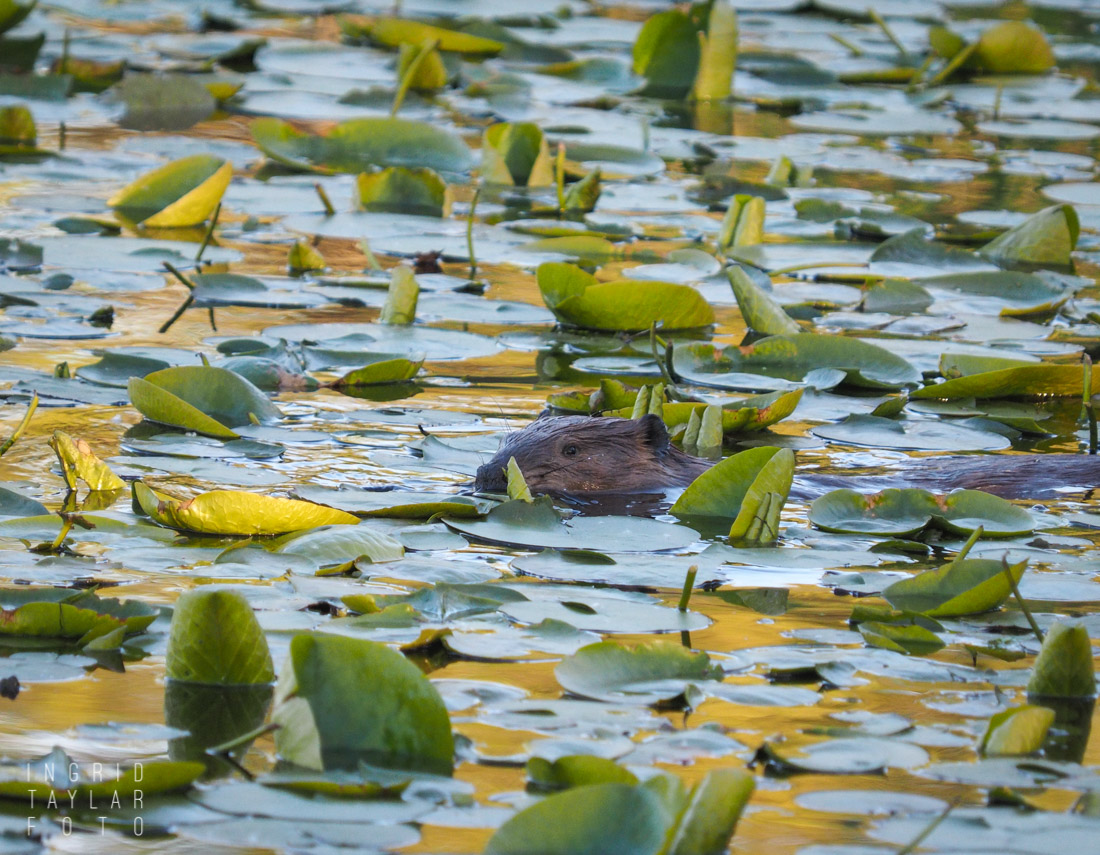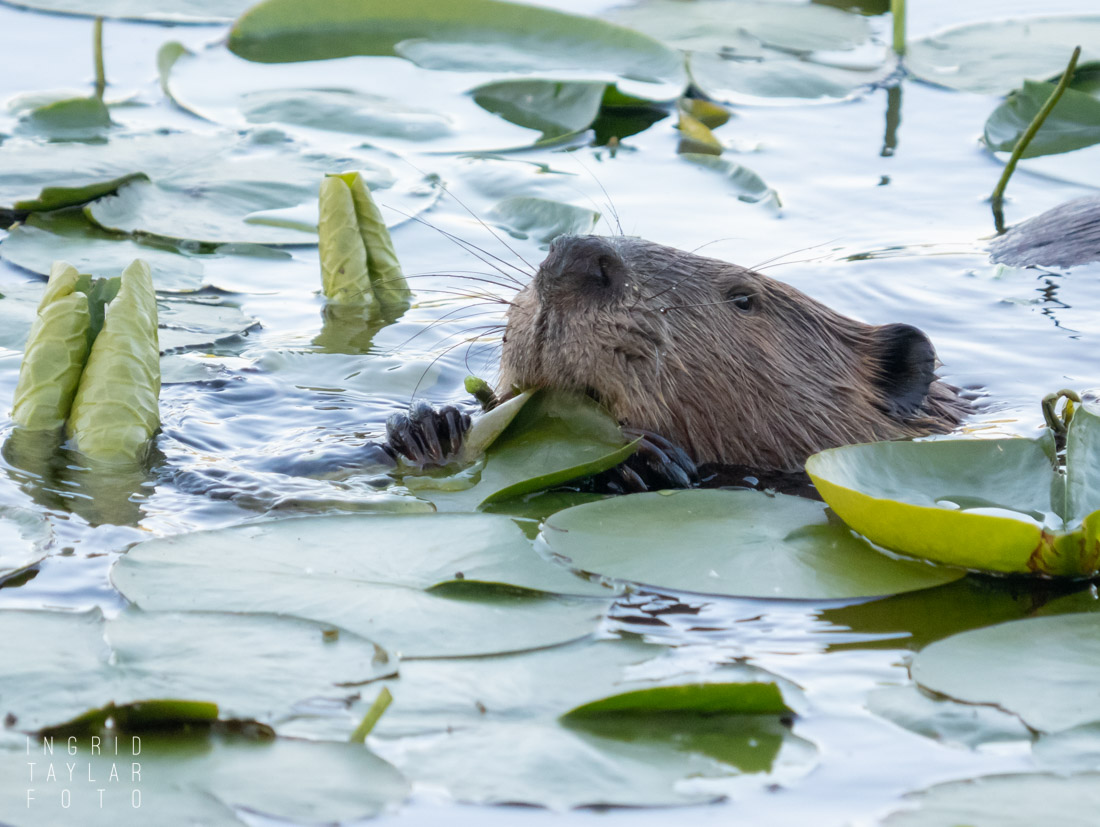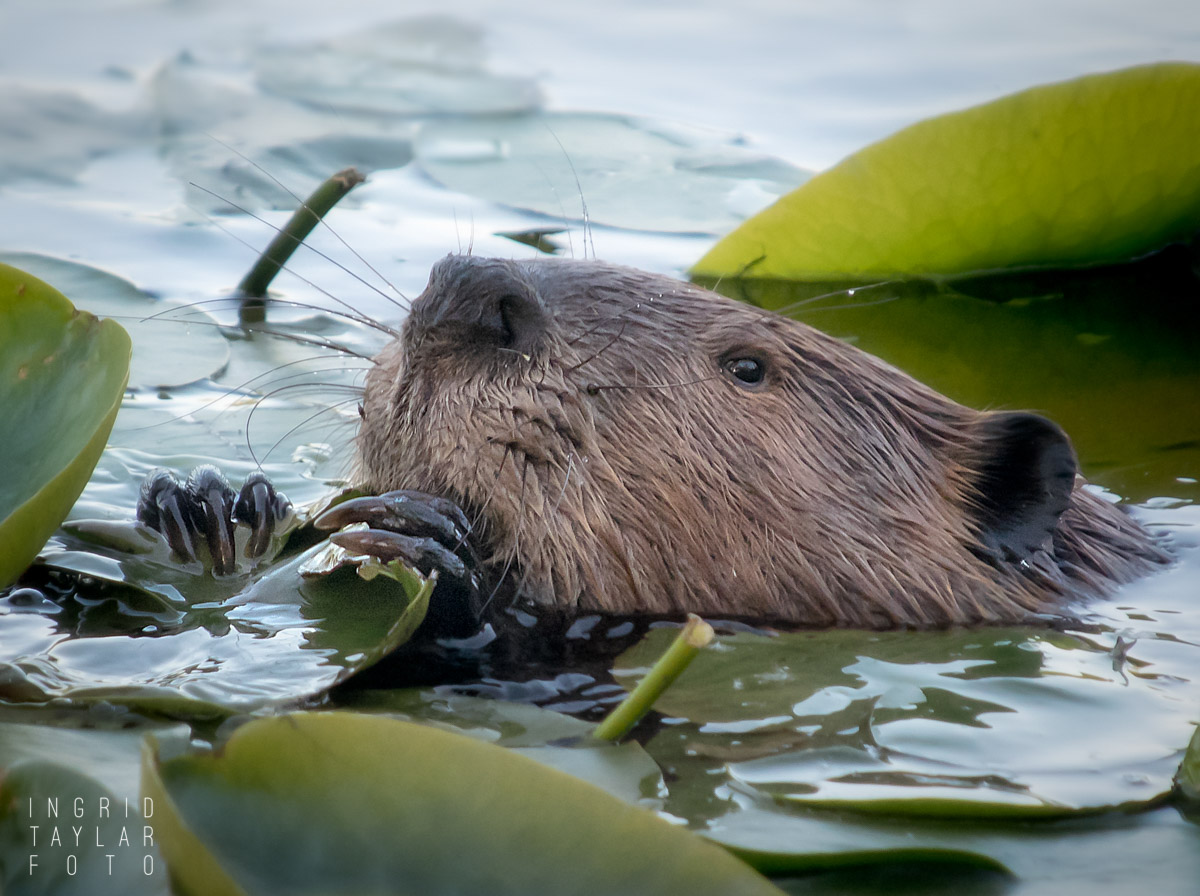It’s like waiting for a geyser to erupt … or an eclipse. There’s a start time to this endeavor. At 6:45p, we’re told, a North American beaver or two (or more) will swim into this stew of lily pads and systematically take them down for dinner. They have a lodge not far away, this family of four.
It’s plain good fortune on our part, taking a spontaneous walk on the shoreline trail, that we encounter a local photographer who knows everything about the area: which Red-winged Blackbird nested where; the spot where the vole made his mansion; why the muskrat liked the shade under the boardwalk; and — most pertinent here — the beaver’s arrival time. He’s generous with his information and enthusiasm, and we are grateful. We would have left before sundown had we not learned about the main event.
At 6:30p, an astute eye spots a head popping up at the distant shoreline. ID confirmed: North American beaver en route.

The light is on the wane, with sundown splitting rays through the branches of maples and alders. The only chance at a crisp image is if one of the beavers swims into a fleeting patch of sun with his head turned toward the light. “They seem to like the lily pads at this end,” our photographer guide says.
The beaver doesn’t comply with the sun. He’s alone as he meanders over to where we are. In the shade, he chews his way through a lily pad buffet, rolling the leaves sometimes so tight in his agile little paws, they look like enchiladas verdes — some say like cigars.
Images shot at ISO 1250, and processed in Lightroom and Photoshop to enhance exposure and details.



As he swims off, we notice another beaver doing turns in a distant patch of sun. We make our way over to the other platform and capture this very last gasp of sunset before the light renders everything a silhouette. You can hear the crunching sound of chewing, in and around the ambient sound of blackbirds, robins and an overhead aircraft.
Beavers are vegetarians, and lily tubers are a favorite foodstuff. Because beavers are crepuscular (loving the twilight), you’ll see them most often at dawn and dusk, which accounts for the predictable in-time of this beaver family.
Beavers were nearly extinct because of the fur trade. Every time I have the privilege to spend time with an animal that barely evaded extinction (Peregrines, Brown Pelicans, egrets, sea otters, etc.) I’m reminded of this John Muir quote:
“God has cared for these trees, saved them from drought, disease, avalanches, and a thousand tempests and floods. But he cannot save them from fools.”
May all beavers and their brethren be so fortunate as to enjoy their lives, eating lilies on the lake, without running into those fools.

Splendid video. The still image is great, but the video adds a lot of dimension for an unusual animal like this one (for me anyway). I think you’re using a tripod? The video is really steady and good quality.
Something interesting I found out about the Beaver:
“In Chicago, several beavers have returned and made a home near the Lincoln Park’s North Pond. The “Lincoln Park beaver” has not been as well received by the Chicago Park District and the Lincoln Park Conservancy, which was concerned over damage to trees in the area. In March 2009, they hired an exterminator to remove a beaver family using live traps, and accidentally killed the mother when she got caught in a snare and drowned. Relocation costs $4,000–$4,500 per animal. Scott Garrow, District Wildlife Biologist with the Illinois Department of Natural Resources, opined that relocating the beavers may be “a waste of time”, as there are records of beaver recolonizing North Pond in Lincoln Park in 1994, 2003, 2004, 2008 and 2009. As of fall 2009 a new beaver lodge has appeared on North Pond’s northwest bank.” Apparently authorities are giving up and trying to coexist with Beavers. Hurray!
Hear this: “Both beaver testicles and castoreum, a bitter-tasting secretion with a slightly fetid odor contained in the castor sacs of male or female beaver, have been articles of trade for use in traditional medicine. Yupik medicine used dried beaver testicles like willow bark to relieve pain. Dried beaver testicles were also used as contraception. Beaver testicles were used as medicine in Iraq and Iran during the tenth to nineteenth century. Castoreum continues to be used in perfume production.”
I’m bringing this up because I documented the Castor Oil Plant (https://wp.me/p44pnT-M8) and (https://wp.me/p44pnT-Mu) The common name “castor oil” probably comes from its use as a replacement for castoreum, a perfume base made from the dried perineal glands of the beaver (castor in Latin).
How abusive to use such a noble animal for both pelt and perfume. What exploitation, when there’s already a Castor Oil Plant that replaces this oil, and pelts belong to the inhumane fur trade. I’m renewing my membership with PETA. I know they may be somewhat fanatical, but at least they raise their voice to media platforms. What I still don’t like about PETA is their increased belief in euthanasia. I know some animals may have to be euthanised to cease painful agony, but rumours once leaked that PETA was euthanising way too many animals. I hope I’m wrong.
Maria, that video was handheld with the E-M1, and I didn’t plan the shot well to follow the beaver’s movements. I forgot both my tripod and monopod at home in the morning rush to get to my meeting. So, it was spontaneous. I’m still a neophyte when it comes to video. I’m fully aware of how difficult great video shooting (and coverage) is. There was a tiny bit of camera shake, but small enough that iMovie’s stabilization correction fixed it. I adjusted for about 30 percent (if you’re familiar with iMovie).
How interesting about the castoreum! I had no idea. See … this is what you do so well, finding the fascinating, tangential stories that go along with the core story. Thank you. Your information makes the whole encounter that much more dense for me, in terms of layers of understanding.
As far as the beaver trapping, this process pains me more than I can handle at times. I learned from the same photographer that they’re trapping and killing beavers in Everett, north of Seattle. Get this — they build a wetland and then trap the beavers who show up to use the resources. I’ve been in touch with a few people, trying to get more information, but it’s unsurprisingly difficult to find out.
The worst part about trapping in general is that pelts are sold on the international market. It blows my mind that USFWS can allow a practice where the wildlife in our PUBLIC trust is killed in the most brutal way — and make no mistake, trapping is horrific — so the trappers can make a buck selling their pelts to Asia. That paradigm belongs in the 19th century, not ours! Trapping to me, has no ethical underpinnings and can’t even be given the leeway of subsistence hunting. It’s commercial at its core, affecting, again the wildlife in the trust of all of us. This Michigan DNR document describes the process of the trade, for anyone who’s interested: https://www.michigan.gov/documents/dnr/TEM_Chapt_16_206598_7.pdf
BTW, this exposure at ISO 1250 shows amazing detail. I love the detail of the claws grasping the enchilada-like leaves.
What I notice at ISO 1250 on the E-M1 is a lot of grain and, of course, a bit of reduced clarity/sharpness because of it. It’s not traditional color noise, as far as I can see … the yellow/green element. It’s a grain, which I prefer. So, my post-processing on images like that involves Lightroom, Photoshop and sometimes Nik ColorEfex. I sharpen, sometimes selectively, reduce noise, work with levels, whites and blacks, and then, sometimes use detail extractor in ColorEfex to bring out a bit of texture in an otherwise softer image. That being said, an image like this is fine for blogging, but I wouldn’t want to use it for a large print. Converting to B&W is one other option, something I do from time to time. I enjoy B&W processing in general, but am cognizant that sometimes I use it for photo salvation.
I’ve been reducing noise selectively with PS CS6. When I resize for posting on the blog, I notice I get even more noise, so I do most of the noise reduction after I have resized. LR is great for reducing noise, but I stayed with PS only to avoid all the multi-tasking involved with LR, although soon I will end up taking the Adobe offer to get in the Cloud. I’m still not in the Cloud because Adobe has continued updating the old CS6 for free; but eventually they will stop doing it and even now the CS6 from the Cloud is getting new features which are not in the old CS6.
You have to love those fortunate encounters! Great shot of the beaver and I love the video. Thank you for bringing the plight of this misunderstood animal to light. They were nearly extirpated from North America by trapping at one point in out history. Foolish people.
Love the photo and video! Beavers are just so darned cute. I did an interpretive sign project recently near Spokane about how beavers are gaining respect, especially in arid places. Turns out, they work like “eco-restorers”, restoring wetlands, and they work for free! Plus, some agencies have figured out it is easier to use beavers to build small-scale dams than to apply for permits. In Seattle, there is an ongoing issue in Golden Gardens Park – where beavers are cutting down trees and infuriating some park visitors. The Parks Dept. is trying to convince people that beavers are part of nature and not vermin.
I’d like to share here, a beautiful post by a British blogger, who blogged about a Robert Burn’s poem dedicated to a mouse. Robert Burns was an famous Scottish poet and lyricist with heightened sensibilities.
He writes, and this is an excerpt of the poem:
“I’m truly sorry man’s dominion
Has broken Nature’s social union,
And justifies that ill opinion
Which makes thee startle
At me, thy poor, earth born companion
And fellow mortal!
I doubt not, sometimes, but you may steal;
What then? Poor little beast, you must live!”
The post has the full poem in a video, narrated in an English-Scottish dialect (which cannot be understood) but the images are simply breathtaking. The whole poem is in the post if you’d like to read it in full:
https://suedreamwalker.wordpress.com/2014/05/13/painting-for-pleasure/
Love the beaver photo and video. He looks as if he doesn’t have a care in the world. He’s content munching and crunching on a lily pad carefully selected from the profusion of pads around him. Such an innocent look on his gentle (herbivore) face!
In the video tribute to Robert Burns’ “To a Mouse,” I was enjoying the scenes of little mice peeking out from their shelters when, all of a sudden, I was startled to see a scene of devastation and destruction: the Twin Towers, which one shone with a silvery sheen, were reduced to pile of rubble after being brought down on 9/11 (by controlled demolition, according to 2,200 architect and engineer who support the nonprofit Architects and Engineers for 9/11 Truth: http://www.ae911truth.org).
Beavers and mice I could watch all day long. Perhaps the men who make war on their brothers and sisters for profit and power could learn a thing or two from watching the beavers and mice–a thing or two about humility, simplicity, and peaceful coexistence.
The words “one shone with a silvery sheen” should be “once shone….”
What very special footage you shot there! That beaver sure makes eating lily pads look delicious.
Never was certain what harms were brought to the beaver community – Although it would be strange if they were the only species not negatively impacted by our human hands… I think the sweet poem Maria F. linked to says it all. I think too that we’ve broken all contracts of mutual respect. Literally trapping creatures to steal their lives away. Sad.
Excellent photo and video! I was just witnessing this at our cottage and we weren’t sure if it was a beaver or muskrat. Can hear the crunching but he seems a bit shy if you just appear without hiding behind trees to observe him. But now convinced it’s a beaver. Anyway – wonderful photo!